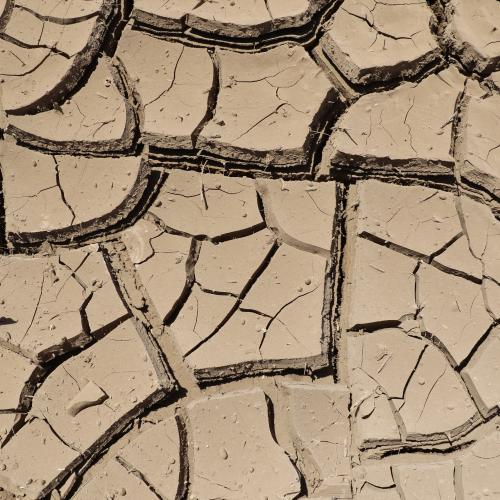
Drought
Droughts and water stress is a recurrent feature of Europe’s climate, with severe consequences for people and for most economic sectors, including agriculture.
While droughts are considered a natural phenomenon characterised by slow onset and long duration, scientists recognise that there are many different types of drought. It can be of meteorological, agricultural, hydrological, or socioeconomic nature, and occur on different time scales and with different impacts.


Meteorological droughts may be exacerbated by high temperatures (heatwaves). Hydrological droughts are more severe and long lasting, and take place in areas with low groundwater levels, affecting watercourses, water resources, and natural ecosystems.


Water scarcity is a result of human activities (where demand exceeds available resources) and has a direct effect on vulnerability and response to drought episodes.
Water scarcity and drought increasingly affect ecosystems, agriculture, energy production and water supply in regions that already suffer from water stress. In combination with the increasing likelihood of severe heatwaves, droughts pose a significant threat for Europe, with water stress currently affecting one third of EU territory all year round. Alongside the changing climate, human decisions significantly affect the occurrence and impact of drought.
The EDO indicates that 16% of the EU’s area of groundwater is affected by over-abstraction, where the amount of water taken is greater than the amount of water falling as rain. This leads to water scarcity and soil compaction, erosion, and reduced water-holding capacities, which contribute to increasing the likelihood of droughts and their negative impacts.
Largely based on national disaster risk assessments for EU Member and Civil Protection Mechanism Participating States, the ‘Overview of natural and man-made disaster risks the European Union may face’ aims to foster better understanding of disaster risks facing Europe.
Droughts have severe consequences for people and for most economic sectors, including agricultural, forest, energy production, industry, river transport (waterways) and public water supply. Compared to other natural disasters that unfold over a matter of hours, drought is characterised by a slow onset and long duration. It can have a variety of possible impacts that can last for months or years after the event ends.
According to the PESETA IV report, a 40–80 % increase in the severity of droughts is predicted by 2050 (except in northern European regions). Projected increases in water consumption will further contribute to the issue in most regions of Europe (except in northern countries).


As stated in the EDO Analytical report, the extreme droughts in central and northern Europe in the spring and summer of 2018, which led to unprecedented wildfires in Scandinavia, could become the norm within 25 years.
The majority of the Member States that included it in their risk assessment reports considered the effects of climate change on drought risk and often-covered impacts on critical infrastructure: disruption of electricity networks, road transport, and water provision, as well as the agricultural and forest sector. Secondary hazards, such as wildfires, air and water pollution, risks to food security, and food price volatility were also highlighted.
The main overall objective of EU water policy is to ensure access to good quality water in sufficient quantity for all Europeans, and to ensure the good status of all water bodies across Europe. Therefore, policies and actions are set up in order to prevent and to mitigate water scarcity and drought situations, with the priority to move towards a water-efficient and water-saving economy.
The Water Framework Directive requires the Member States to prepare River Basin Management Plans including Programmes of Measures for each River Basin District, including for international river basins, to among other things address the quantitative status of water bodies. The Regulation on minimum requirements for water reuse increases agricultural water reuse by offering a sustainable, alternative water supply for irrigation.
The EU 2030 Biodiversity Strategy, aiming at putting Europe’s biodiversity on the path to recovery by 2030, with a view to ensuring that by 2050 all of the world’s ecosystems are restored, resilient, and adequately protected, has restoration of freshwater ecosystems as one of its main objectives.
The Commission encourages all Member States to use natural water retention measures, as reflected in a national policy document, a practical guide and a platform containing a wealth of information and practical examples.
Furthermore, the United Nation’s Global Assessment Report Special Report on Drought 2021 calls for immediate action to reduce drought risks and meet the targets of the 2030 Agenda for Sustainable Development and the Sendai Framework for Disaster Risk Reduction.
Among the many reports on this topic, two in particular are to be mentioned:
The European Regional Development (ERDF) and Cohesion Funds invest in cooperation between Member States for drought prevention and management.
The European Agricultural Fund for Rural Development (EAFRD) implements the common agricultural policy, which supports a wide range of actions to increase resilience to drought through CAP Strategic Plans 2023-2027. These include improving water retention capacity in soils and establishing forest protection belts, shifting towards more resistant and less water-intensive crops, and improving the efficiency of irrigation equipment and infrastructure.
The national CAP Strategic Plans 2023-2027 will contribute, inter alia, to environmental and climate objectives and will aim to encourage productive changes through additional voluntary payments, such as eco-schemes and nature-based solutions contributing to climate change adaptation and mitigating the impacts of natural disasters (e.g. drought, forest fires, soil erosion, and floods).
The European Drought Observatory (EDO), run by the European Commission’s Joint Research Centre (JRC), monitors current and past droughts and their impact on soils, vegetation and groundwater levels in the EU. The Commission also closely cooperates with the European Environment Agency (EEA) to improve the collection and comparison of data on droughts across Member States.